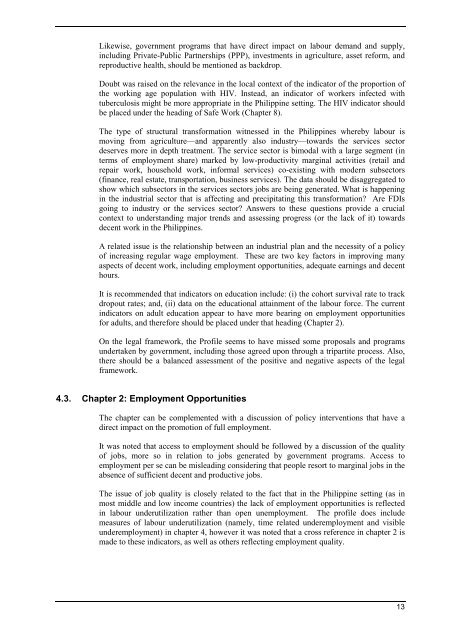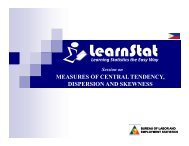Tripartite Validation Workshop of the Philippines Decent Work ...
Tripartite Validation Workshop of the Philippines Decent Work ...
Tripartite Validation Workshop of the Philippines Decent Work ...
Create successful ePaper yourself
Turn your PDF publications into a flip-book with our unique Google optimized e-Paper software.
Likewise, government programs that have direct impact on labour demand and supply,<br />
including Private-Public Partnerships (PPP), investments in agriculture, asset reform, and<br />
reproductive health, should be mentioned as backdrop.<br />
Doubt was raised on <strong>the</strong> relevance in <strong>the</strong> local context <strong>of</strong> <strong>the</strong> indicator <strong>of</strong> <strong>the</strong> proportion <strong>of</strong><br />
<strong>the</strong> working age population with HIV. Instead, an indicator <strong>of</strong> workers infected with<br />
tuberculosis might be more appropriate in <strong>the</strong> Philippine setting. The HIV indicator should<br />
be placed under <strong>the</strong> heading <strong>of</strong> Safe <strong>Work</strong> (Chapter 8).<br />
The type <strong>of</strong> structural transformation witnessed in <strong>the</strong> <strong>Philippines</strong> whereby labour is<br />
moving from agriculture—and apparently also industry—towards <strong>the</strong> services sector<br />
deserves more in depth treatment. The service sector is bimodal with a large segment (in<br />
terms <strong>of</strong> employment share) marked by low-productivity marginal activities (retail and<br />
repair work, household work, informal services) co-existing with modern subsectors<br />
(finance, real estate, transportation, business services). The data should be disaggregated to<br />
show which subsectors in <strong>the</strong> services sectors jobs are being generated. What is happening<br />
in <strong>the</strong> industrial sector that is affecting and precipitating this transformation? Are FDIs<br />
going to industry or <strong>the</strong> services sector? Answers to <strong>the</strong>se questions provide a crucial<br />
context to understanding major trends and assessing progress (or <strong>the</strong> lack <strong>of</strong> it) towards<br />
decent work in <strong>the</strong> <strong>Philippines</strong>.<br />
A related issue is <strong>the</strong> relationship between an industrial plan and <strong>the</strong> necessity <strong>of</strong> a policy<br />
<strong>of</strong> increasing regular wage employment. These are two key factors in improving many<br />
aspects <strong>of</strong> decent work, including employment opportunities, adequate earnings and decent<br />
hours.<br />
It is recommended that indicators on education include: (i) <strong>the</strong> cohort survival rate to track<br />
dropout rates; and, (ii) data on <strong>the</strong> educational attainment <strong>of</strong> <strong>the</strong> labour force. The current<br />
indicators on adult education appear to have more bearing on employment opportunities<br />
for adults, and <strong>the</strong>refore should be placed under that heading (Chapter 2).<br />
On <strong>the</strong> legal framework, <strong>the</strong> Pr<strong>of</strong>ile seems to have missed some proposals and programs<br />
undertaken by government, including those agreed upon through a tripartite process. Also,<br />
<strong>the</strong>re should be a balanced assessment <strong>of</strong> <strong>the</strong> positive and negative aspects <strong>of</strong> <strong>the</strong> legal<br />
framework.<br />
4.3. Chapter 2: Employment Opportunities<br />
The chapter can be complemented with a discussion <strong>of</strong> policy interventions that have a<br />
direct impact on <strong>the</strong> promotion <strong>of</strong> full employment.<br />
It was noted that access to employment should be followed by a discussion <strong>of</strong> <strong>the</strong> quality<br />
<strong>of</strong> jobs, more so in relation to jobs generated by government programs. Access to<br />
employment per se can be misleading considering that people resort to marginal jobs in <strong>the</strong><br />
absence <strong>of</strong> sufficient decent and productive jobs.<br />
The issue <strong>of</strong> job quality is closely related to <strong>the</strong> fact that in <strong>the</strong> Philippine setting (as in<br />
most middle and low income countries) <strong>the</strong> lack <strong>of</strong> employment opportunities is reflected<br />
in labour underutilization ra<strong>the</strong>r than open unemployment. The pr<strong>of</strong>ile does include<br />
measures <strong>of</strong> labour underutilization (namely, time related underemployment and visible<br />
underemployment) in chapter 4, however it was noted that a cross reference in chapter 2 is<br />
made to <strong>the</strong>se indicators, as well as o<strong>the</strong>rs reflecting employment quality.<br />
13



